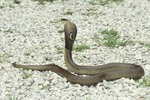
As the most populous country on the African continent, the Republic of Nigeria is known as the “Giant of Africa.” Its diverse landscapes and climatic conditions, including rainforest, coastal plains, mangroves and vast savannah, account for Nigeria’s wide biodiversity of flora and fauna, including abundant species of snakes. Among them are several venomous ones: the West African carpet viper, gaboon viper, puff adder and black-necked spitting cobra.
West African Carpet Viper
Primarily nocturnal, the West African carpet viper (Echis ocellatus) is 1 to 2 feet long with speckled light to dark brown dorsal scales and a light-colored belly. A sidewinder, it lifts its upper body, braces its head and pulls the remaining coils along without touching the ground at an angle. It ranges throughout Nigeria in its natural habitat of forest edges and savannah, up to 3,000 feet above sea level.
The carpet viper accounts for 90 percent of the snake bites in Nigeria, and 60 percent of human snakebite fatalities -- mostly farmers and young children, according to the Medical Journal of Therapeutics. The carpet viper’s breeding season coincides with heavy rainfall during the annual monsoon season, driving it to seek shelter in higher, drier habitats to lay eggs. Farmers, most of whom harvest crops by hand, are at high risk from these aggressive snakes, whose potent hemotoxic venom make it the most dangerous snake in all Africa and, in terms of morbidity and mortality, the most dangerous snake in the world. Victims experience blistering, swelling, hemorrhaging and tissue damage that may result in necrosis.
Gaboon Viper
Ranging throughout the tropical rainforests and other moist regions of East and West Central Africa, the terrestrial gaboon viper (Bitis gabonica) hunts for rodents, birds and frogs during the evening hours. A heavy snake, it ranges from 4 to 6 feet and its brown color and leaf-shaped head provide excellent camouflage under leaves on the forest floor. Viviparous, the gaboon viper gives birth to 30 to 60 live young.
Infamous for having the longest fangs among snakes, up to 2 inches, the gaboon viper is responsible for several snakebites in Nigeria each year; its potent venom is deadly to humans, if not treated promptly.
Puff Adder
The puff adder (Bitis arietans) is distributed throughout North Africa. Non-aggressive and sluggish, it's responsible for 60 percent of reported snake bites, making it one of the most dangerous snakes on the continent. Its potent venom is cytotoxic and injected by front-hinged fangs that fold out when the mouth opens and retract when it closes, like a switchblade knife. Human victims of their bite will die if not treated within 26 hours, or deep necrosis may set in, requiring amputation of the affected body part.
Adult puff adders generally reach about 3 feet long with dull yellow, orange, brown and beige markings providing excellent camouflage. Preferring open grassland, savannah, open woodlands and rocky outcrops, they prey upon rodents and birds.
Black-Necked Spitting Cobra
Displaying a characteristic open hood, the black-necked spitting cobra (Naja nigricollis) spits when provoked. It's a highly venomous snake responsible for many human bites and fatalities every year in its range from Nigeria to Namibia. This olive-brown snake with the black back and a yellow to red underbelly has a broad, dark-colored throat band. It's nocturnal and preys on toads, lizards, grasshoppers and rodents. Females grow up to 6 feet and males are about 4.5 feet long. Females lay 10 to 20 eggs (oviparous) each breeding season.
Non-Venomous Snake Species
In Nigeria, many snakes are difficult to identify; both poisonous or non-poisonous species meet with certain death if they crawl near human habitation. Due to the high incidence of snakebites, many farmers raise pigs, which are immune to snakebites, to clear the land of snakes. Deforestation, mistaken identity and a taste for snake meat have all had a negative impact on the non-venomous snake population in the region, including those species that are useful to humans by keeping rodent populations in check.
References
- All Africa; Nigeria: Snakes Kill 200 in Bauchi; Catherine Agbo
- Medical Journal of Therapeutics; Snake Bites in Nigeria; B. Paramonte
- Living National Treasures: Nigeria, Endemic Reptile Species
- NCBI Resources; Snake Bite in Nigeria
- Guiness World Records: Snake With the Longest Fangs
- Mark O'Shea: Reptile World: West African Carpet Viper
- Venomous and Poisonous Animals Biology & Clinical Management: Carpet Vipers
- Rain Forest Animals: Gaboon Viper
- Namibian.org: Black Necked Spitting Cobra
- Oyivo in Nigeria; Journey to Valley of the Snakes
Resources
- Alex Abutu's Blog; A Season of Snake Bites
- Megasphera: Photographs of the Venomous Snakes of Africa
- AC Snakes: House Snakes
- Venomous Snakes of the World; Mark O'Shea
- University of California: Snakebite Protocols
- Science Direct; Antivenom Therapy of Carpet Viper
- Snake Pictures: Puff Adders
- Snake Pictures: Gaboon Vipers
- Snake Pictures: Spitting Cobras
- Echi Tab Plus ICP: Photograph of West African Carpet Viper
Photo Credits
-
Visage/Stockbyte/Getty Images
Writer Bio
Based in Ontario, Susan Dorling has written professionally since 2000, with hundreds of articles published in a variety of popular online venues. Writing on a diverse range of topics, she reflects her passion for business, interior design, home decorating, style, fashion and pets.




